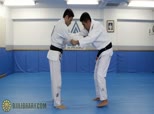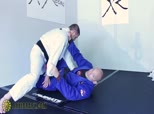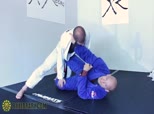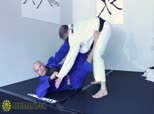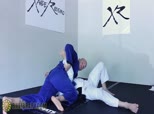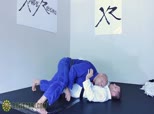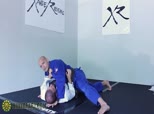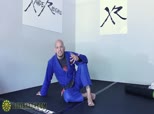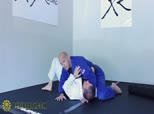Takamasa Watanabe Series 2 - Tai Otoshi to Ankle Pick
Add to Favorites Remove From Favorites 1363 1165 days ago
With the standard collar and elbow grips, Takamasa steps in and pivots, putting his leg across his opponent's far shin to try a tai otoshi takedown. His opponent reacts by stepping over the leg, so he keeps his hand on the collar, drops to his knee and grabs the heel and picks up the leg. While pushing on the collar, he stands up, switches his stance and uses the collar to pull his opponent to the mat, finishing the takedown.
Takamasa Watanabe Series 1 - Interview
Add to Favorites 839 Remove From Favorites 1166 days ago
Takamasa Watanabe, black belt under Rickson Gracie, talks about his background in Jiu-Jitsu, growing up in Rio, and opening Axis Jiu-Jitsu in Tokyo to be the first ambassador of Brazilian Jiu-Jitsu in Japan.Xande's Jiu Jitsu Fundamentals 35 - Protecting the Inside from Classic Guard
Add to Favorites 611 Remove From Favorites 1170 days ago
Xande covers the importance of protecting the inside from the classic guard, which is essentially preventing your opponent from controlling your hip with his knee and forcing the half guard. In the case his opponent is able to force the half, Xande shows how to use your elbow and hand to regain the inside, insert the shield and recover guard.Xande's Jiu Jitsu Fundamentals 34 - Threatening the Neck and Avoiding the Leg Smash Pass from Classic Guard
Add to Favorites 600 Remove From Favorites 1171 days ago
Xande covers another way to maintain his classic guard by threatening his opponent's neck whenever he begins to apply pressure on Xande. If he doesn't get the choke, he can retain his guard. If his opponent is strong enough to smash his legs, Xande becomes elegant and posts on his forearm so he can turn his body down and pull his leg free to recover guard.Xande's Jiu Jitsu Fundamentals 33 - Maintaining Classic Guard with Knee Shield
Add to Favorites 493 Remove From Favorites 1172 days ago
Xande covers the basics of maintaining his classic collar and sleeve guard, whether his opponent stands up to back away or kneels down to apply pressure. Xande uses his knee shield to create space, and his foot on the hip or pedal to create leverage. Another concept he comes back to is using the archer pose, when he pulls the sleeve up high, to create space to establish his pedal.Xande's Jiu Jitsu Fundamentals 32 - Controlling the Arm from Side Control
Add to Favorites 522 Remove From Favorites 1174 days ago
Xande goes over some different ways to control your opponent's arm from side control. First is by using your hip in his armpit to force his arm down like an Americana. He also shows how to pass the arm all together and control from more of a north south position, and some possible arm lock setups.Xande's Jiu Jitsu Fundamentals 31 - Explaining Control when Reversing Side Control
Add to Favorites 554 Remove From Favorites 1176 days ago
Xande answers Alex's question on where to focus his weight to control his opponent when reversing side control. When in normal side control, he is focused on controlling the chest to the hips, but when he reverses, his focus switches on controlling the chest to shoulders.Xande's Jiu Jitsu Fundamentals 30 - Using Esgrima Pressure to Force the Half Guard from Butterfly
Add to Favorites 573 Remove From Favorites 1178 days ago
From his opponent's butterfly guard, Xande presses forward and shifts his hips to pose two. From here he looks to push the leg with one hand while his other works for the underhook. While maintaining pressure with his head in his opponent's chest, Xande inches his way to the side, forcing himself to his opponent's half guard.Xande's Jiu Jitsu Fundamentals 29 - Pose Two Explained - Pressure
Add to Favorites 512 Remove From Favorites 1184 days ago
In pose two Xande is on his hip and his legs are opposite as they were in pose one, so his top leg is in front this time. Pose two is great for applying pressure from the top, especially side control.Xande's Jiu Jitsu Fundamentals 28 - Pose One Explained - Defense and Transition
Add to Favorites 541 Remove From Favorites 1185 days ago
Xande goes into detail on pose one, which is when he is on one hip with his bottom foot in front and his top foot posted in back. This is the primary pose for any defensive position. This pose can also be used from a top position, but should be more of a transitional position rather than one of control.Xande's Jiu Jitsu Fundamentals 27 - Pose Zero Explained - Controlling and Resetting
Add to Favorites 532 Remove From Favorites 1186 days ago
Xande explains what pose zero is and how he applies it to his Jiu Jitsu. It is a neutral position which he can use to control his opponent from top or bottom, most commonly in side control or closed guard.Xande's Jiu Jitsu Fundamentals 26 - Toreando Dribble Pass to Knee on Belly
Add to Favorites 549 Remove From Favorites 1187 days ago
Going into detail on the toreando pass, Xande first shows his preferred grip on the pants, which is with his thumbs pointing down. This grip is harder for your opponent to break. He likes to do a dribble or push-pull to the legs before stepping around to the side and establishing knee on belly. At this point his opponent will likely turn into him, so he drops his arm to the far hip and drops his hip to the mat for a strong side control.
